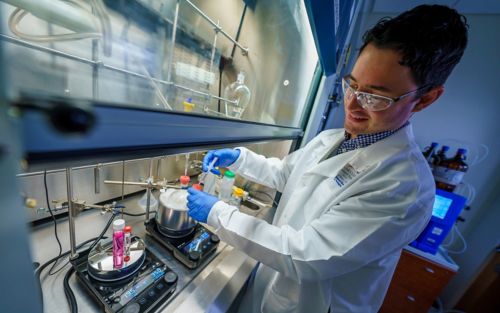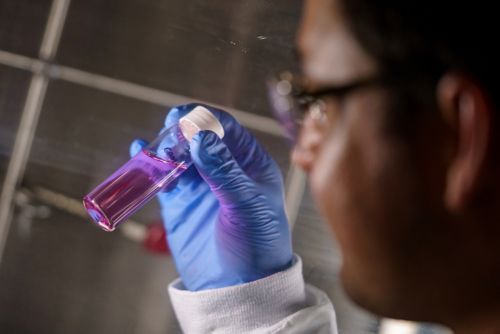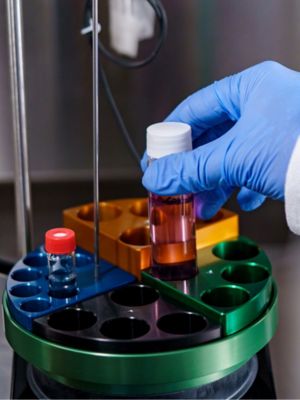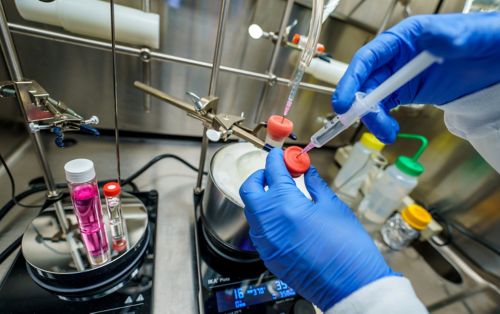St. Jude Family of Websites
Explore our cutting edge research, world-class patient care, career opportunities and more.
St. Jude Children's Research Hospital Home

- Fundraising
St. Jude Family of Websites
Explore our cutting edge research, world-class patient care, career opportunities and more.
St. Jude Children's Research Hospital Home

- Fundraising
Daniel Blair Lab
Exploring the frontiers of covalent inhibitors and automated synthesis to find targets for the treatment of pediatric diseases
About the Blair Lab
At the heart of fundamental biology is nature’s ability to make and break chemical bonds. This chemical reactivity, finely tuned and optimized through evolution, can lead to disease when there are modifications in how these bonds are formed or broken. Our laboratory designs covalent chemical matter that reacts and interacts with biological machinery to amplify or deactivate various biological functions. Understanding this chemical reactivity offers a potential innovative strategy for treating diseases.

Our research summary
Modifications in chemical reactivity or functionality can lead to pediatric diseases. Many approaches for making medicines have historically relied upon non-covalent interactions to target disease-causing biomolecules. Our laboratory strives to amplify or deactivate biological functions through the design of covalent chemical matter, which makes or breaks chemical bonds with disease-causing biomolecules. Leveraging the ability to make or break these bonds in a strategic, precise way may lead to new and innovative treatment methods for pediatric diseases.

Most antibiotics target ribosomes, the key piece of machinery that creates all proteins. There are promising hints that small, chemically reactive molecules may be effective for targeting ribosomes in treatment approaches. Forming new chemical bonds to ribosomes may prolong the action of a medicine at a particular molecular site. Expanding our knowledge in this area could lead to a strategy for revitalizing antibiotics that have diminished in effectivity due to their overuse. This research is the first step toward the creation of chemical matter that selectively and covalently targets RNA.

Another area of our laboratory’s research inquiry revolves around disulfide bonds and how the making or breaking of those chemical bonds can lead to a protein’s activation or deactivation. Disulfide bonds typically serve as the guardians of protein function. But their aberrant or malfunctional behavior underlies diseases like cancer and celiac disease, as well as disorders such as depression, and are integral components during viral infection. Despite this association of disulfide bonds and disease, we lack effective chemical matter for therapeutic intervention. Our goal is to create reactive chemical matter to intercept disulfide bonds with precise chemical reactions and to establish disulfide bonds as a new class of therapeutic target.

Chemical space is huge, which makes it hard to explore efficiently. To accelerate access to new functional chemicals, our team is developing modularized and automated methods to make these small molecules. By unifying these modular automated pipelines for making molecules with powerful techniques for finding new biological functions, we aim to identify new targets for the selective interception of pediatric diseases.
Whether we explore chemical bonds and reactivity in ribosomal RNA, disulfide bonds, or build automated systems that allow us to make small molecules to aid our research efforts, our team’s commitment to advancing treatments for children with catastrophic diseases underscores all our efforts.
Publications
Contact us
Daniel Blair, PhD
Assistant Member
Department of Chemical Biology and Therapeutics
MS 1000, Room E8064
St. Jude Children's Research Hospital
Memphis, TN, 38105-3678 USA
Follow Us

Memphis, TN, 38105-3678 USA GET DIRECTIONS